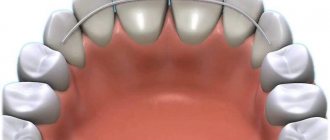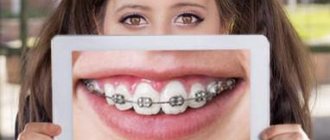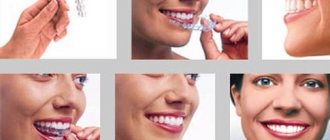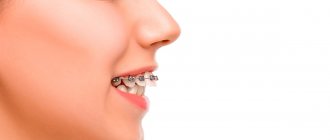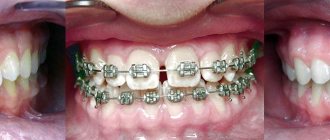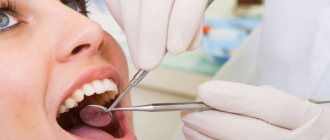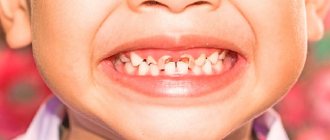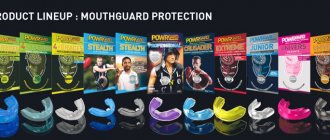This is a headache and a nightmare for any orthodontist: a patient who has had his braces removed and given a removable retainer and instructions for its use returns after some time with complaints about the curvature of his previously straight teeth. The retention period is the most psychologically difficult part of the treatment. Everything is already perfect, and then you have to wear a retainer. Yes, there are other reasons for the unsuccessful outcome of the correction. And although they are much less common, let’s talk about them in more detail.
Correction principle
The method of correcting malocclusion with braces is based on the principle of creating constant pressure on the teeth. Under pressure, the tooth root begins to press on the socket on one side, thereby causing rarefaction of the bone tissue. In the direction of rarefaction, the tooth moves. On the other side of the hole, bone tissue, on the contrary, grows. Thus, after a certain period of time, not only the position of the tooth changes, but also the shape of the socket, which prevents the tooth from returning to its original place.
Correct your bite or dental defect with invisible aligners Find out what it is
Bone tissue grows quite quickly, but it takes quite a long time to “ripen”. That is why, after finishing wearing the brace system, a removable retainer is made for the patient for another year or two or a splint is installed on the incisors and canines. Additional fixation during the retention period helps to avoid repeated tooth curvature.
The basic principle of dental correction
Many people know that in the dental system, as well as in other systems of the body, nothing happens for nothing. Various anomalies and pathologies also have their own causes and symptoms. It is for this reason that in order to achieve a good effect when correcting a bite, these points should be taken into account and all efforts should be directed towards correcting it.
The installation of a braces system is aimed at returning teeth that have left their “rightful” places to their natural position without surgical intervention and complex deformations. When installing braces, it is necessary to adjust the position of the elastic bands so that the design completely corrects the patient’s bite.
After all the elastic bands have been tensioned correctly, everything should then be entrusted to the ligaments located in the celibular part of the skull. They are particularly elastic and can change their position, albeit very slowly. To prevent teeth and ligaments from returning to their previous position, retainers should be installed. These designs allow you to consolidate the achieved result.
Possible problems after removing braces
Some people's teeth diverge quickly after completing the correction stage. During the first year, some individuals may only slightly rotate around their axis. Everything is individual, but some general patterns can be identified.
Fanned teeth
A rapid relapse after braces are removed may be due to the following factors:
- Refusal of retainers. Patients often refuse permanent retainers because their installation damages tooth enamel. And it’s annoying to wear removable retainers, even those that are worn only at night. As a result, the teeth return to their previous position, since the new position has not yet been “overgrown” with bone tissue.
- Individual characteristics. There are people in whom new formation and “maturation” of bone tissue proceeds faster than others. And there are those for whom this process is delayed. For some, the displacement of teeth in order to correct the shape of the dentition was insignificant, while for others the tooth “came a long way” before taking its place in the dentition. Teeth quickly “huddle together” after crowding is eliminated. The teeth, which were mixed with braces around their axis, easily turn back.
- Breakage of braces, use of a system of inadequate quality. If the pressure on the teeth during correction was not constant, then the likelihood of an unfavorable outcome increases. You shouldn’t walk around with a broken arch or unstuck locks for a week. It is better to see a doctor on the same day. This will save you from many problems.
- Tooth extraction. When there is not enough space for teeth in the dentition, the orthodontist may decide to remove the “extra” ones. Most often these are fours, eights, less often sixes. The absence of fangs can cause the formation of a diastema. Removing a six causes significant displacement of adjacent teeth.
Loose teeth after braces
Occurs infrequently. In most cases, the feeling of excessive tooth mobility after removing braces is deceptive. It may appear at the very beginning of the retention period and disappear on its own and without treatment. It's another matter if the teeth are really loose. In this case, it is better to seek help from a specialist.
Pain in the teeth and gums
There may be some discomfort after removing braces. Pain occurs especially often after eating solid foods. The reason for this is a change in the condition of the ligaments that hold the roots of the teeth, as well as an increase in the sensitivity of the enamel if the remineralization procedure was not carried out. Reducing the chewing load and using special medications that reduce the sensitivity of teeth and gums help reduce pain.
What determines the stability of treatment?
The preservation of the result in orthodontics is usually called retention. Retentio is a Latin term meaning "preservation", "retention". So, maintaining a beautiful smile does not depend on the money paid by the patient. Even after correction with the coolest expensive ceramic braces or transparent Invisalign aligners, the teeth can move apart very quickly. In some cases, this is due to the fault of the doctor, but much more often the patient himself becomes the source of the problem.
- The teeth will definitely become crooked again if the orthodontist has not identified and eliminated the real cause of the anomaly.
- The doctor is also responsible for the correctness of the treatment program. This means that he must correctly choose the orthodontic design and directions of tooth movement, as well as carefully approach the need to remove those that interfere with effective correction.
- When drawing up a program, a professional will initially focus on a high-quality result, and not on accelerated treatment. With a patient who wants to wear only the “magic” Smartclip self-ligating braces in order to have as few visits to the clinic as possible and correct the bite faster, it is difficult to find a compromise. But without this, it will be impossible to realize his dream of an even, white-toothed smile.
- Finally, to consolidate the result after removing braces, the specialist must offer the patient the optimal retention device. In this case, one should take into account the psychological characteristics of the individual demonstrated during long-term treatment.
This limits the orthodontist's responsibility. If all the rules were followed, and the teeth become crooked again, the patient can only blame himself.
Why are teeth loose?
To understand the reason why a tooth is loose, you need to know how the braces system works and how it works. The design of the bracket system is such that a small lock is attached to each tooth according to a certain pattern. An orthodontic arch made of shape memory material is installed in the fastenings of each lock. This arch puts pressure on the dentition and promotes tooth movement.
What causes the displacement? Under the influence of a directed load, the bone tissue on one side decreases, the tooth socket expands, which allows the tooth to move to a new location. At the same time, in order for him to sit firmly in a new place, on the other hand, the bone tissue must grow, this process takes time. During the period when the socket has already widened, and not enough new bone tissue has grown, the teeth can be mobile. That is, their mobility during the period of movement is the norm, which should not frighten. The main thing is to fix the tooth in its new place in the jawbone after displacement.
Causes of tooth displacement
After orthodontic treatment is completed, teeth tend to return to their original position. The most common causes of dentition displacement are:
- patient's refusal to wear retainers,
- non-compliance with the rules of operation of the splinting structure,
- deformation or other damage to the retention system, as a result of which it loses its functions.
Another risk factor is the incorrect selection of a retention device. An experienced doctor should choose a design taking into account the structural features of the patient’s dental system. If this is not done, the retainer will not be able to cope with the high load, which will worsen the treatment result and will most likely lead to relapse.
Types of retainers
Depending on the characteristics of malocclusion and the degree of results achieved, the orthodontist determines the tactics of the retention period regarding the type of structure, the duration of daily exposure to retainers and the timing of their wearing.
There are two main types of retainers.
- Fixed. They are a thin wire that is fixed on the inside of the teeth using special glue or filling material. The retainer is absolutely invisible to prying eyes, does not cause significant discomfort and does not affect diction.
- Removable. Several types of removable retainers are produced, but the main design is presented in the form of a mouthguard, which is made exclusively individually in accordance with the anatomical features of the patient’s teeth and jaw. Removable retainers are worn primarily at night or for several hours a day.
Trainers, plates, mouthguards and aligners are used in the form of removable orthodontic products for the retention period.
A removable design requires longer adaptation and regular wearing of the structure. Orthodontists recommend that parents monitor compliance with the requirements for correction, and if there are indications for wearing a structure, they should always give preference to non-removable retainers.
The importance of using retainers after wearing braces and aligners
Braces and aligners correct teeth, and the patient does not need further medical supervision - a false statement.
Wearing braces lasts 1-2 years. Naturally, the patient is happy to have them removed and have an even row of teeth. To consolidate the effect, it is necessary to use retainers - metal arches that are attached to the lingual surface of the front teeth. They prevent secondary curvature of teeth. Retainers can be non-removable (metal arches) or removable (aligners). The former are prescribed to adults and adolescents, the latter are more often prescribed to children and adolescents. The doctor decides whether the mouthguard will be effective for an adult patient. Wearing a mouth guard requires discipline - wearing it at night will help straighten teeth stay in place.
I'm already old/too old for braces
In fact, today the framework in orthodontic treatment has been completely erased. Of course, each age has its own subtleties of work for a doctor. However, the result is always the same. And one more fact - people sometimes lose their teeth not because of caries and other dental problems, but because of an incorrect bite. When the load is distributed unevenly, it ultimately leads to bone loss and tooth wear.
I will not tire of repeating that we do straight teeth not only to solve aesthetic problems. Often this will save you from early tooth loss.
The importance of a retainer in the fight for straight teeth
Muscle memory is long and strong, and it takes a lot of effort to direct it in a different direction. Retainers are needed so that muscles, bone tissue, and ligaments become accustomed to the physiologically correct position. The participation of the patient is important: follow all the doctor’s recommendations, wear removable retainers for the time prescribed by the doctor, and clean non-removable ones. Anyone who completes treatment will receive a lasting positive result. For those who have gone through a long period of treatment with braces, using retainers will not seem difficult.
Parents are required to help their child follow all the dentist’s instructions. A significant amount of money was paid for the treatment, the most difficult stage is over, now there is no need to stop there. The main task is to consolidate the result and smile. Consistency is important when using removable retainers, but it pays off in the end result. The patient already sees his straight teeth, this is the greatest motivation to make further efforts.
What to do if your teeth are crooked
If the curvature is too severe, braces will likely need to be reinstalled. If the defect is minor, you can get by with regular retainers. In any case, if the slightest changes are detected in the oral cavity, the patient should immediately seek advice from his doctor.
There are situations when, even after installing a mouth guard or wire, the teeth still move apart. This is due to incorrect position or an error in the manufacture of the model. But, unfortunately, most often this happens due to the fault of the patient at the dental clinic.
Tired of wearing bulky orthodontic appliances, a person feels freedom and stops monitoring the condition of his teeth. He may forget to wear a mouthguard, not pay due attention to oral hygiene, etc. All this can lead to complications: the appearance of caries, inflammation, as well as displacement of units to their usual position. It is very important to follow all the recommendations of the doctor, who, after dismantling the structure, will definitely prescribe the use of a specific retainer, toothpastes, strengthening compounds, brushes of optimal hardness, etc.
Reasons for the appearance of distal bite, why it is dangerous
The causes of the defect may be genetic disorders, especially in cases where relatives had a similar diagnosis.
Sometimes the occurrence of pathology is facilitated by a lack of nutrients, microelements, as well as bad habits.
– sucking toys, pacifiers.
Often, instead of a pacifier, the child uses a finger to suck
- which undoubtedly contributes to the development of distal occlusion:
The structure of the dental apparatus is disrupted in the presence of untreated diseases of the nasopharynx - breathing through the mouth provokes weakening of muscles, ligaments and jaws shift.
Correction of distal bite with braces is necessary. If you ignore pathology, you will have to overcome many problems.
Problems arising from distal occlusion:
- Diction is broken.
- There is no adequate chewing of food, not all foods are convenient to eat. Gastrointestinal ailments or somatic diseases develop.
- It is difficult to get dentures in the future.
- Uneven load often leads to loosening of units and destructive changes in tissues.
The dentist will make an initial conclusion during the first examination and order imaging to clarify the diagnosis.
Rules for wearing retainers
In order to prevent the reverse process of correcting the bite, you should strictly follow all the rules for wearing an orthodontic appliance:
- Don't take on the role of a specialist and stop wearing removable braces on your own. Only an orthodontist can determine the duration of the retention period. This question takes into account the patient’s age, genetic predisposition, and individual characteristics of the oral cavity.
- During hygiene procedures when operating a fixed device, the set of necessary tools should be expanded. In addition to a toothbrush, it is recommended to use special brushes and dental floss.
- Plastic aligners should be removed from the mouth before each meal , otherwise they may become deformed during the chewing process.
- As an additional oral care product, it is worth using a fluoride-containing rinse , which will strengthen the structure of tooth enamel.
Professional cleaning is recommended at least twice a year.
Types of aesthetic braces, their advantages and disadvantages.
In this publication, we will look at methods for treating crowded teeth without braces.
Follow the link https://orto-info.ru/ortodonticheskoe-lechenie/osnovnoy-period/operatsiya-radikalnoe-ispravlenie-defektov.html if you are interested in the price of orthognathic surgery.
Preventive actions
To prevent teeth from moving apart in the future after removing braces, you must strictly follow the advice and recommendations of specialists. For the first six months, the system should be worn 24 hours a day, and only in the next six months can braces be worn only at night. After a year and a half, braces are installed every other night.
The doctor should monitor the correction of the bite at least twice a month. To prevent relapse, it is still recommended to install retainers after removing braces.
In what cases is loose teeth not normal?
Rarely, there are situations when the cause of tooth loosening is not in the physiological process of resorption and growth of bone tissue, but in some kind of disease.
For example, teeth may become loose if a patient develops osteomyelitis or osteoporosis. Also a common cause of pathological loosening is periodontal disease in the acute stage. Teeth become mobile due to gingivitis, periodontal disease, and periodontitis.
And if bone pathologies arise on their own, then periodontal diseases are most often caused by insufficient hygienic oral care and braces.
In any case, to exclude pathology of the bones or gums, at the first sign of loose teeth, you should consult a dentist. The doctor will conduct a full diagnosis, determine why the teeth are loose and, depending on the results of the examination, prescribe treatment or give recommendations.
